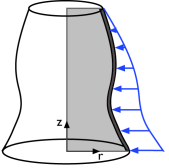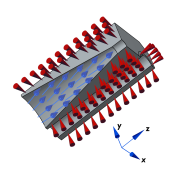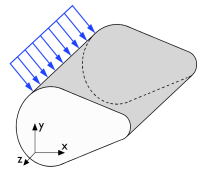The 2D physics interface for plane stress allows loads in the x and
y directions, and assumes that these are constant throughout the material’s thickness, which can vary with
x and
y. The plane stress condition prevails in a thin (compared to the in-plane dimensions) flat plate in the
xy-plane loaded only in its own plane and without any
z direction restraint.
Loads in the x and
y directions are allowed. The loads are assumed to be constant throughout the thickness of the material, but the thickness can vary with
x and
y. Formally, the plane strain condition requires that the ends of the object are constrained in the
z direction, but it is often also used for central parts of an object that is long in the
z direction (compared to the in-plane dimensions). One example is a long tunnel along the
z-axis where it is sufficient to study a unit-depth slice in the
xy-plane.
In the default version of the interface, displacements occur only in the r-z plane, and there are two degrees of freedom, u and
w. By selecting the
Include circumferential displacement option, you can model also torsion around the axis of rotational symmetry. The azimuthal rotation degree of freedom
v is then included. In addition, many features, such as load features, allow values to be entered in the

direction.
The 2D axisymmetric geometry is viewed as the intersection between the original axially symmetric 3D solid and the half plane  = 0
= 0,
r ≥ 0. Therefore, the geometry is drawn only in the half plane
r ≥ 0, and it recovers the original 3D solid by rotating the 2D geometry about the
z-axis.




